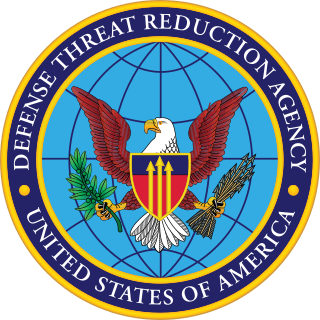Related Research Articles

The Federal Emergency Management Agency (FEMA) is an agency of the United States Department of Homeland Security, initially created by Presidential Reorganization Plan No. 3 of 1978 and implemented by two Executive Orders on April 1, 1979. The agency's primary purpose is to coordinate the response to a disaster that has occurred in the United States and that overwhelms the resources of local and state authorities. The governor of the state in which the disaster occurs must declare a state of emergency and formally request from the president that FEMA and the federal government respond to the disaster. The only exception to the state's gubernatorial declaration requirement occurs when an emergency or disaster takes place on federal property or to a federal asset—for example, the 1995 bombing of the Alfred P. Murrah Federal Building in Oklahoma City, Oklahoma, or the Space Shuttle Columbia in the 2003 return-flight disaster.

The Defense Threat Reduction Agency (DTRA) is an agency within the United States Department of Defense (DoD) and is the official Combat Support Agency for countering weapons of mass destruction. According to the agency's Strategic Plan for Fiscal Years 2018 to 2022, the DTRA mission "enables DoD and the U.S. Government to prepare for and combat weapons of mass destruction and improvised threats and to ensure nuclear deterrence." The agency is headquartered in Fort Belvoir, Virginia.

The United States Under Secretary of Defense for Policy (USDP) is a high level civilian official in the United States Department of Defense. The Under Secretary of Defense for Policy is the principal staff assistant and adviser to both the Secretary of Defense and the Deputy Secretary of Defense for all matters concerning the formation of national security and defense policy.

In the United States Government, the Bureau of European and Eurasian Affairs (EUR) is part of the U.S. Department of State, charged with implementing U.S. foreign policy and promoting U.S. interests in Europe and Eurasia, as well as advising the Under Secretary of State for Political Affairs. It is headed by the Assistant Secretary of State for European and Eurasian Affairs. The spokesperson is A. Wess Mitchell.

The Bureau of International Security and Nonproliferation (ISN) is a bureau within the United States Department of State responsible for managing a broad range of nonproliferation and counterproliferation functions. The bureau leads U.S. efforts to prevent the spread of weapons of mass destruction and their delivery systems.

The Armed Forces Radiobiology Research Institute (AFRRI) is a triservice laboratory in Bethesda, Maryland, USA, and was chartered by the U.S. Congress in 1961. It conducts research in the field of radiobiology and related matters which are essential to the operational and medical support of the U.S. Department of Defense (DoD) and the U.S. military services. AFRRI provides services and performs cooperative research with other federal and civilian agencies and institutions.

Signed into effect on 12 June 2002, the Public Health Security and Bioterrorism Preparedness and Response Act, (PHSBPRA) was signed by the President, the Department of Health and Human Services (DHHS) and the U.S. Department of Agriculture (USDA).
The National Biodefense Analysis and Countermeasures Center (NBACC) is a government biodefense research laboratory created by the U.S. Department of Homeland Security (DHS) and located at the sprawling biodefense campus at Fort Detrick in Frederick, MD, USA. The NBACC is the principal U.S. biodefense research institution engaged in laboratory-based threat assessment and bioforensics. NBACC is an important part of the National Interagency Biodefense Campus (NIBC) also located at Fort Detrick for the US Army, National Institutes of Health and the US Department of Agriculture.
A Sector is a shore-based operational unit of the United States Coast Guard. Each Sector is responsible for the execution of all Coast Guard missions within its Area of Responsibility (AOR), with operational support from Coast Guard Cutters and Air Stations. Subordinate commands within a Sector typically include Stations and Aids-to-Navigation (ATON) Teams. Some Sector commands also have subordinate units such as Sector Field Offices and Marine Safety Units that are responsible for mission execution in parts of the Sector's AOR. There are 37 sectors within the Coast Guard.

The Project Bioshield Act was an act passed by the United States Congress in 2004 calling for $5 billion for purchasing vaccines that would be used in the event of a bioterrorist attack. This was a ten-year program to acquire medical countermeasures to biological, chemical, radiological, and nuclear agents for civilian use. A key element of the Act was to allow stockpiling and distribution of vaccines which had not been tested for safety or efficacy in humans, due to ethical concerns. Efficacy of such agents cannot be directly tested in humans without also exposing humans to the chemical, biological, or radioactive threat being treated, so testing follows the FDA Animal Rule for pivotal animal efficacy.
The Biomedical Advanced Research and Development Authority (BARDA) is a U.S. Department of Health and Human Services office responsible for procurement and development of countermeasures principally against bioterrorism, but also including chemical, nuclear and radiological threats as well as pandemic influenza and emerging diseases. BARDA reports to the Office of the Assistant Secretary for Preparedness and Response and manages Project BioShield. BARDA also procures materials, such as vaccines, for the Strategic National Stockpile, and more broadly is an established interface between the U.S. Government and the biomedical industry. BARDA also manages the governmental inter-agency Public Health Emergency Medical Countermeasures Enterprise, providing coordination across the government in development and deployment of such countermeasures.

The Air Force Safety Center is a Field Operating Agency with headquarters at Kirtland Air Force Base, N.M.

The Bureau of Arms Control, Verification and Compliance (AVC) is a bureau within the United States Department of State. It is responsible for providing oversight of policy and resources of all matters relating to the verification of compliance, or discovery of noncompliance, with international arms control, nonproliferation, and disarmament agreements.
The Lisbon Protocol to the 1991 Strategic Arms Reduction Treaty was a document signed by representatives of Russia, Belarus, Ukraine, and Kazakhstan that recognized the four states as successors of the Union of Soviet Socialist Republics and all of them assume obligations of the Soviet Union under the START I treaty. The protocol was signed in Lisbon, Portugal, on May 23, 1992.

The Pandemic and All-Hazards Preparedness Reauthorization Act of 2013 is a law enacted by the 113th United States Congress. The Act amends the Public Health Service Act in order to extend, fund, and improve several programs designed to prepare the United States and health professionals in the event of a pandemic, epidemic, or biological, chemical, radiological, or nuclear accident or attack. The Act clarifies the authority of different American officials, makes it easier to temporarily reassign personnel to respond to emergency situations, and alters the process for testing and producing medical countermeasures. The Act is focused on improving preparedness for any public health emergency.
The Vienna Document is an agreement between the participating states of the Organization for Security and Co-operation in Europe which was intended to implement confidence and security building measures. Its provisions include an annual exchange of military information about forces located in Europe, notifications for risk reduction including consultation about unusual military activities and hazardous incidents, prior notification of certain military activities, observation of certain military activities, exchange of annual calendars, and compliance and verification by inspection and evaluation visits. This exchange differs from the Global Exchange of Military Information in that it is limited to forces in Europe, while the Global Exchange of Military Information applies to all forces of the participating states, wherever located. The annual exchange of information was conducted concurrently with the annual exchange of information under the Conventional Forces in Europe treaty, in Vienna, Austria in December of each year. The Vienna Document has been revised periodically, and the current version is the 2011 version.
Global Exchange of Military Information is an arms control annual exchange of information sponsored by the Organization for Security and Co-Operation in Europe. Under this agreement, all participating states exchange information about all of their military forces throughout the world. This exchange differs from that under the Vienna Document in that it is not limited to forces in Europe, that is, between the Atlantic and the Urals. The information that is exchanged includes:
Transparency in Armaments (TIA) is an arms control reporting program established by the United Nations General Assembly on December 9, 1991 under UN resolution 46/36L. It calls for annual reporting by UN member states on imports, exports, and holdings of weapons in seven categories: battle tanks; armored combat vehicles; large caliber artillery systems; attack helicopters; combat aircraft; warships; and missiles and missile launchers. Reporting is not required but is strongly encouraged. Reports are sent to the Secretary General of the United Nations and are maintained in the United Nations Conventional Arms Register (UNCAR).

Soviet Nuclear Threat Reduction Act of 1991, 22 U.S.C. § 2551, was chartered to amend the Arms Export Control Act enacting the transfer of Soviet military armaments and ordnances to NATO marking the conclusion of the Cold War. The Act sanctions the Soviet nuclear arsenal displacement shall be in conjunction with the implementation of the Treaty on Conventional Armed Forces in Europe.

The Joint Arms Control Implementation Group is a specialist defence component affiliated to UK Joint Forces Command; which carries out a range of arms control and verification functions. JACIG was originally based at RAF Scampton ; established in 1990, it was declared by the MOD as operational on 1 January 1991. Originally it was formed to performing treaty associated tasks as part of the UK's commitment to post Cold War confidence building associated with the Vienna Document and the Treaty on Conventional Armed Forces in Europe. Its operating base is currently RAF Henlow in Bedfordshire.
References
- ↑ "About DTIRP". Defense Treaty Ready Inspection Readiness Program. Archived from the original on 3 January 2014. Retrieved 3 January 2014.
- ↑ "About DTIRP Authority". Defense Treaty Ready Inspection Readiness Program. Archived from the original on 3 January 2014. Retrieved 3 January 2014.
- 1 2 3 "About DTIRP:Origin and Evolution". Defense Treaty Ready Inspection Readiness Program. Archived from the original on 3 January 2014. Retrieved 8 January 2014.